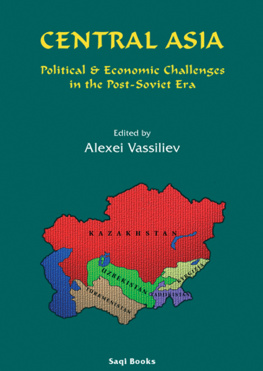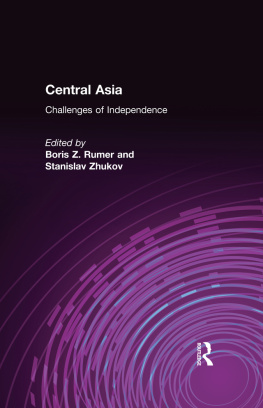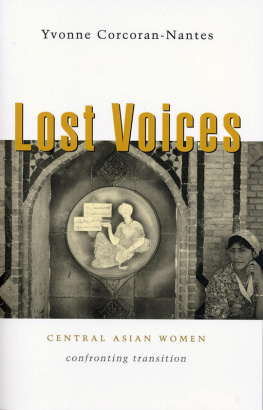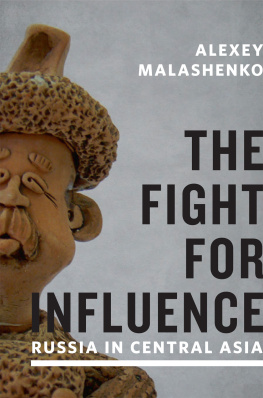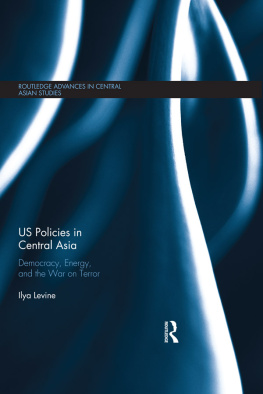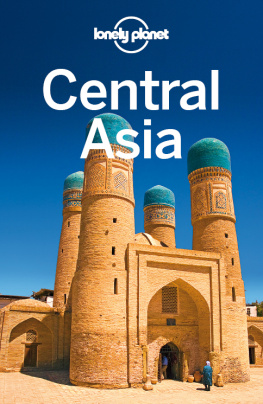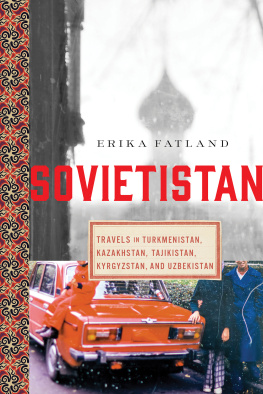Alexei Vassiliev - Central Asia: Political & Economic Challenges
Here you can read online Alexei Vassiliev - Central Asia: Political & Economic Challenges full text of the book (entire story) in english for free. Download pdf and epub, get meaning, cover and reviews about this ebook. year: 2000, publisher: Saqi Books, genre: Politics. Description of the work, (preface) as well as reviews are available. Best literature library LitArk.com created for fans of good reading and offers a wide selection of genres:
Romance novel
Science fiction
Adventure
Detective
Science
History
Home and family
Prose
Art
Politics
Computer
Non-fiction
Religion
Business
Children
Humor
Choose a favorite category and find really read worthwhile books. Enjoy immersion in the world of imagination, feel the emotions of the characters or learn something new for yourself, make an fascinating discovery.
- Book:Central Asia: Political & Economic Challenges
- Author:
- Publisher:Saqi Books
- Genre:
- Year:2000
- Rating:5 / 5
- Favourites:Add to favourites
- Your mark:
- 100
- 1
- 2
- 3
- 4
- 5
Central Asia: Political & Economic Challenges: summary, description and annotation
We offer to read an annotation, description, summary or preface (depends on what the author of the book "Central Asia: Political & Economic Challenges" wrote himself). If you haven't found the necessary information about the book — write in the comments, we will try to find it.
Central Asia: Political & Economic Challenges — read online for free the complete book (whole text) full work
Below is the text of the book, divided by pages. System saving the place of the last page read, allows you to conveniently read the book "Central Asia: Political & Economic Challenges" online for free, without having to search again every time where you left off. Put a bookmark, and you can go to the page where you finished reading at any time.
Font size:
Interval:
Bookmark:
Political and Economic Challenges
in the Post-Soviet Era
Edited by
Alexei Vassiliev
Saqi Books
The monograph has been produced by the Centre for Civilizational and Regional Studies, Russian Academy of Sciences.
Head of the research team: I.V. Sledzevski
List of Contributors
A.M. Vassiliev | Russia and Central Asia |
N.A. Volgina | Kyrghyzstan (economy) |
M.S. Gafarly | Kazakhstan (politics) |
K.P. Dudarov | Turkmenistan (politics) |
L.N. Kalinichenko | Kazakhstan (economy) |
V.F. Kovalski | Kyrghyzstan (politics) |
A.I. Kuzmin | Tajikistan (politics) |
N.I. Petrov | Kazakhstan (politics) |
V.F. Rass | Uzbekistan (economy) |
N.N. Semenova | Kazakhstan (economy) |
V.D. Chernikov | Tajikistan (economy) |
The Soviet empire collapsed. This expression has become a clich in scholarly studies, in the media and in political slang.
Any empire implies the presence of a parent state and colonies. In the case of the Soviet Union, the role of the parent state may be allocated to Russia: the Central Asian countries should be viewed as colonies. The dominant and exploiting nature of the parent state contrasts with the oppression and exploitation of the colonies. This generally gives rise to national liberation movements, which can be manifested either in peaceful or violent forms. The goal of such struggles is the achievement of political independence. Leadership of and participation in such movements legitimizes the advent of new political elites with the power and ability to lead the liberated countries.
Why, then, with the exception of minor displays of nationalism, was there virtually no national liberation movement in the Central Asian colonies? Fear of reprisals? Perhaps, but reprisals did not prevent very different anti-colonial struggle in countries such as Algeria, Vietnam, India, Indonesia, Kenya or Mozambique.
Why did the leadership of the Central Asian republics resist the disintegration of the Soviet Union to the bitter end? Why were they last to leave the USSR, having to be practically pushed out of it, and why do they still preserve so many of the traditional intra-imperial links? Why did the socio-political crisis occur first in the centre of the empire Russia (except for the Baltic region and Western Ukraine), and only then, with such grave consequences, in the colonies?
Some of these questions can be answered if one avoids taking a preconceived approach and being blinded by Russophobia, which is present in an overt or covert form in many discussions about the Soviet empire.
The truth and tragedy of history lies in the fact that the Russian people (together with the Ukrainians and Belorussians) were as much victims of the totalitarian Communist system as were the other Soviet peoples. Moreover, Russia suffered more losses and greater economic difficulties; its national culture was destroyed to a greater extent, and it lost more genetic stock compared with the other ethnic groups in the empire.
Any imperial structure implies the presence of dominant and privileged ethnos(es). In the Soviet Union the Russians, with their demographic weight and level of socio-political development, were the dominant ethnos. The question is, did they enjoy privileged positions in the republics of Central Asia to the same extent as the British and French did in their colonies?
Two social groups occupied the uppermost levels of the social pyramid of the proletarian state and the state of the whole people, namely, the party and state nomenklatura (officialdom), and trade employees. The former enjoyed privileges of power, status, influence, legal nomenklatura benefits (apartments, country cottages, health care, better food, holiday resorts and sanatoriums) and opportunities for illegally acquiring wealth. The latter also enriched themselves by illegal and criminal methods on a large scale. The Russians formed an absolute and sometimes even relative minority in both groups.
Appointment of Russians (Ukrainians, Belorussians) as the second secretaries of the republican Central Committees of the CPSU or heads of the local KGB in each republic did not change the general picture. The situation differed somewhat in Kazakhstan, where many first secretaries of the Central Committee were Russians. But even there, in spite of the demographic preponderance of Russians in the republic, they did not form the majority of either the party-state nomenklatura or trade employees.
The majority of the Russian and Russian-speaking population in the republics were workers, and included those employed in the more dangerous and often less prestigious industries, such as coal- and ore-mining. They were over-represented among the local technical intelligentsia, scientists and teachers. There were almost no Russians among the nomads or cotton growers, the most deprived part of the local population. Yet they were also under-represented in the socially most privileged strata of the population.
The local political elite found itself incorporated into the multinational Soviet nomenklatura to a much greater degree than was the case of, for example, the Georgian nobility during the all-Russian aristocracy period of Tsarism. However, though adhering to the traditional clan, ethnic, tribal or regional bias in the Central Asian republics, the local political elite nevertheless had to espouse the ideals of Communism in order to have any chance of progressing up the hierarchical ladder: this encompassed an open allegiance to Communist ideology, atheism, internationalism, and declarations of friendship with big brother, i.e. Russia. In the post-Stalin period the centre interfered only rarely with the internal power struggles going on between the local ruling elites.
The Central Asian political elites have not changed: they preserve the generic features of the Soviet nomenklatura, but it should be emphasized that their roots were and are in the local clans. They assumed the leading roles in the newly independent states not because they had fought for freedom, but because they were rejected by the victorious Russian anti-Communists who precipitated the break-up of the Soviet Union.
In their efforts to legitimize themselves under the new political conditions, these leaders have turned to nationalism and, to an extent, to Islam. Once Russifiers, leaders in these states now express anti-Russian attitudes and appeal for the revival of national, historical and cultural values; once preachers of atheism, the elites now demonstrate their religious devotion, takes oaths on the Quran and worship frequently at mosques.
All of them are aware that Russia, immersed in its own crisis, poses no threat to them. They have powerful positions in their local clans, and therefore are not challenged by their own people, either the professional classes or the downtrodden and silenced lower strata of the population. These authoritarian regimes, which have only changed their political colours, are in control of the security forces and the mass media, and therefore are in possession of sufficient power to manage the situation. Any challenges to their positions emanate only from rival clans, who aspire to the same levels of influence and wealth. They can turn to Islamic fundamentalism. The long civil war in Tajikistan was a struggle between clans, despite claims to the contrary. But the Islamists may form a counter-elite, and be able to resist the ruling clans. Therefore, while supporting the Islamic revival, it has begun to dawn on those in power that the slogans of Islam are a double-edged sword.
Font size:
Interval:
Bookmark:
Similar books «Central Asia: Political & Economic Challenges»
Look at similar books to Central Asia: Political & Economic Challenges. We have selected literature similar in name and meaning in the hope of providing readers with more options to find new, interesting, not yet read works.
Discussion, reviews of the book Central Asia: Political & Economic Challenges and just readers' own opinions. Leave your comments, write what you think about the work, its meaning or the main characters. Specify what exactly you liked and what you didn't like, and why you think so.

